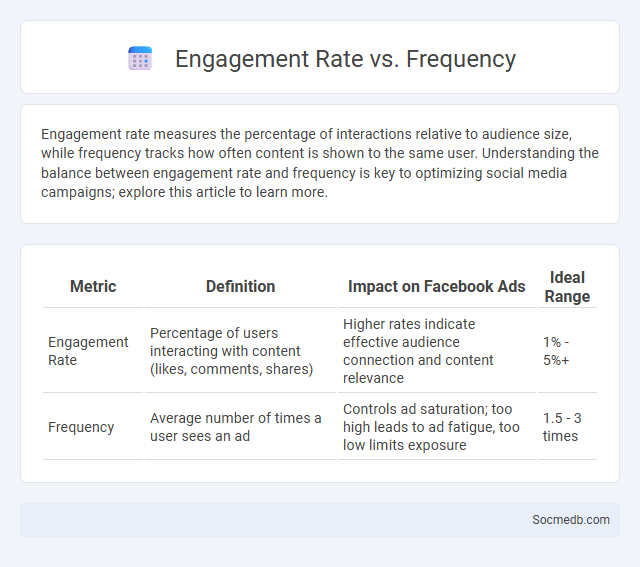
Photo illustration: Engagement Rate vs Frequency
Engagement rate measures the percentage of interactions relative to audience size, while frequency tracks how often content is shown to the same user. Understanding the balance between engagement rate and frequency is key to optimizing social media campaigns; explore this article to learn more.
Table of Comparison
| Metric | Definition | Impact on Facebook Ads | Ideal Range |
|---|---|---|---|
| Engagement Rate | Percentage of users interacting with content (likes, comments, shares) | Higher rates indicate effective audience connection and content relevance | 1% - 5%+ |
| Frequency | Average number of times a user sees an ad | Controls ad saturation; too high leads to ad fatigue, too low limits exposure | 1.5 - 3 times |
Introduction to Engagement Rate and Frequency
Engagement rate measures the percentage of your audience interacting with your social media content through likes, comments, shares, and clicks, providing insight into content effectiveness. Frequency refers to how often your audience sees your posts within a specific period, impacting both reach and potential audience fatigue. Monitoring these metrics helps you optimize content strategy to boost interaction and maintain audience interest.
Defining Engagement Rate in Digital Marketing
Engagement rate in digital marketing measures the level of interaction your audience has with social media content by calculating the ratio of likes, comments, shares, and clicks to total followers or impressions. This metric helps marketers evaluate the effectiveness of campaigns and understand how well content resonates with target users. Enhancing your engagement rate drives higher brand awareness and fosters stronger connections with potential customers.
Understanding Frequency in Content Campaigns
Understanding frequency in social media content campaigns is essential for maximizing audience engagement without causing fatigue. High-frequency posting can increase brand visibility and reinforce messaging, but excessive repetition may lead to diminishing returns and audience disengagement. Analyzing platform-specific algorithms and user behavior helps optimize posting schedules to balance reach and retention effectively.
How Engagement Rate and Frequency Interact
Engagement Rate measures how actively Your audience interacts with social media content through likes, comments, and shares, while Frequency refers to how often content is posted within a specific period. High posting Frequency can increase visibility but may lower Engagement Rate if the audience feels overwhelmed or saturated. Balancing these metrics ensures that Your content maintains relevance without causing audience fatigue, optimizing both reach and interaction.
Importance of Balancing Engagement Rate and Frequency
Balancing engagement rate and frequency on social media is crucial for maintaining audience interest without causing content fatigue. High engagement rates indicate strong connections, but overly frequent posts can overwhelm followers and decrease interaction quality. Optimal scheduling ensures consistent visibility while fostering meaningful engagement for sustained brand growth.
Impact of High Frequency on Engagement Rate
High-frequency posting on social media significantly boosts the engagement rate by increasing your content's visibility and interaction opportunities. Consistent and frequent updates keep your audience engaged, fostering stronger connections and higher reach through algorithmic preferences for active accounts. Strategic timing and quality content ensure that frequent posts translate to meaningful engagement rather than audience fatigue.
Strategies to Optimize Engagement Rate with Ideal Frequency
Maximizing your social media engagement rate involves identifying the ideal posting frequency that resonates with your audience's behavior and platform algorithms. Research indicates that brands typically see optimal engagement when posting 3-5 times per week on platforms like Instagram and Facebook, while Twitter may require 1-3 tweets daily to maintain visibility without overwhelming followers. You can enhance interaction rates by consistently analyzing performance metrics such as likes, comments, shares, and click-through rates to adjust your scheduling strategy dynamically.
Common Mistakes When Measuring Engagement Rate vs Frequency
Misinterpreting engagement rate by ignoring frequency often leads to skewed analytics, as higher frequency can inflate impressions without genuine interaction growth. Marketers frequently mistake repeated exposure for increased engagement, failing to distinguish between unique user actions and repeated views by the same audience. Accurate measurement requires separating engagement rate metrics from frequency data to assess true audience interaction and campaign effectiveness.
Tools and Metrics for Tracking Engagement and Frequency
Effective social media management relies on tools like Hootsuite, Sprout Social, and Buffer to schedule posts and monitor engagement metrics such as likes, shares, comments, and click-through rates. Tracking frequency involves analyzing posting cadence to optimize audience interaction and maintain consistent visibility across platforms. You can leverage these metrics to refine your content strategy and maximize user engagement efficiently.
Best Practices for Maximizing Engagement Through Frequency Optimization
Posting consistently at optimal times aligns with your audience's online behavior, increasing visibility and interaction rates. Utilizing analytics tools to identify peak engagement periods allows you to strategically schedule content without overwhelming followers. Maintaining a balance between frequency and quality ensures your social media presence fosters meaningful connections and sustained audience interest.
 socmedb.com
socmedb.com